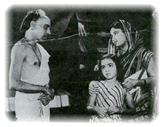- Thyagabhoomi (1939 film)
Infobox_Film
name = Thyagabhoomi

director = K. Subramaniam
writer =Kalki Krishnamurthy
starring = S.D. SubbalakshmiPapanasam Sivan Baby Saroja
A.K. Kamalam
K.J. Mahadevan
producer = K.Subramaniam
distributor =
music =Papanasam Sivan
Mothi Babu
Rajagopala Iyer
cinematography = M.C.Abu Becker
editing =
released =20 May 1939
runtime = 194 min
language = Tamil
imdb_id = 0276559Thyagabhoomi is a 1939 film directed and produced by famous film director K. Subramaniam. Starring K.J.Mahadevan and S.D.Subbalakshmi, the film was produced at the height of India's freedom movement and glorified
Mahatma Gandhi and his ideals in no mean terms. The story for the movie was based on a novel written by the great Tamil writerKalki Krishnamurthy .cite news | last= | first= CVG| title= Versatile writer and patriot | date= 20-3-2001| url =http://www.hinduonnet.com/2001/03/20/stories/13200178.htm | work =The Hindu | accessdate = 2008-05-04] "Thyagabhoomi" is the only Indian film to be banned after release by the British government.Cite web|url=http://sify.com/peopleandplaces/fullstory.php?id=13273735&vsv=1068|title=Mahatma Gandhi and cinema|accessdate=2008-05-03|year=2003|author=Randor Guy] Cite web|url=http://www.indiaclub.com/shop/SearchResults.asp?ProdStock=17201|title=Director K Subrahmanyam - A Biography|accessdate=2008-05-03] cite news | last= | first= | title= Thyagabhoomi (1939) | date= | url =http://movies.nytimes.com/movie/253971/Thyagabhoomi/details | work =The New York Times: Movies | accessdate = 2008-05-03]Production
In
1937 , the pro-independenceIndian National Congress defeated the pro-British Justice Party for the first time in the elections to the Madras Legislative Assembly andChakravarthi Rajagopalachari was sworn in as the Chief Minister. As an immediate consequence of this change of guard, censorship was relaxed on films glorifying the freedom movement and national leaders. Encouraged by the new government's policies, a few films glorifying the freedom movement were made during this period. "Thyagabhoomi" was one of them.cite journal | author=S. Theodore Baskaran| title=War relic | journal=Frontline| year=2006| volume=23| issue=19| url=http://www.hinduonnet.com/thehindu/fline/fl2319/stories/20061006000707900.htm]However, censorship was reimposed when the Congress Government resigned on the eve of India's entry into the
Second World War . TheGovernor of Madras who took over the administration of the province subsequently banned "Thyagabhoomi". The ban evoked severe protests from Indian film-viewers. However, by the time the ban was enforced, Thyagabhoomi had already scaled the pinnacle of success running to packed houses in theatres in and around Madras. While films which carried "potentially seditious" messages were either prohibitied from screening altogether or subject to strict censorship by the British authorities, "Thyagabhoomi" was the first film which was released in theatres in Madras and banned by the British Government. While it is widely believed that "Thyagabhoomi" was banned as soon as the Governor took over the administration in 1940, certain eye witnesses testify that the ban was enacted only in the year 1944.cite news | last= Kumar| first= Amshan | title= Does cinema reflect literature? | date= 16-2-2001| url =http://www.hinduonnet.com/2001/02/16/stories/09160225.htm | work =The Hindu | accessdate = 2008-05-04]Cast
* S.D. Subbalakshmi as Savithri
*Papanasam Sivan as Sambhu Sastry
*Baby Saroja as Charu
* K.J. Mahadevan as Sridharan
* A.K. KamalamPlot synopsis
Sambu Sastri is a
Brahmin priest who sheltersHarijans who had been rendered homeless in a cyclone and is eventuallyexcommunicated from the orthodox Hindu society and moves toMadras . The focus then shifts to Sambu Sastri's daughter Savitri who is illtreated by her Westernized husband Sridharan and is eventually driven out of his palatial house inCalcutta . Meanwhile, Sambu Sastri had offered his ancestral home to Sridharan as dowry and hence Savitri finds herself homeless when she arrives in her native village. She gives birth to a baby girl Charu in hospital and entrusts her to the care of her father and continues on her wanderings. Sambu Sastri, meanwhile, along with Harijan Nallan, embarks on Gandhian social uplift programmes including picketing liquor shops. At the end of the film, Savitri emerges as the wealthy woman under the pseudonym Uma Rani and devotes herself to charitable activities. She eventually rejects the overtures of her husband Sridharan who wishes to return to her.Cite web|url=http://www.imdb.com/title/tt0276559/plotsummary|title=Plot summary from IMDB|accessdate=2008-05-04] Cite web|url=http://www.indiaheritage.org/perform/cinema/regional/tamil.htm|title=India Heritage:Performing Arts:Cinema In India:Regional Cinema |accessdate=2008-05-04|publisher=indiaheritage.com] Cite web|url=http://entertainment.indianetzone.com/films/1/krishnaswamy_subramanyam.htm|title=Krishnaswamy Subramanyam|accessdate=2008-05-04|publisher=indianetzone.com]The character of Sambu Sastri was modelled upon Mahatma Gandhi. The film also included real-life footage of Mahatma Gandhi spinning the "
charkha ".Cite web|url=http://www.indiafilm.com/lm.htm|title=Landmarks in Tamil cinema|accessdate=2008-05-04|publisher=indiafilm.com]Other versions
In
1989 , on the 50th anniversary of the film, atelefilm version was made by director K. Subramaniam's son, S. Krishnaswamy.Cite web|url=http://www.kaplindia.net/pro_fiction.htm|title=Fictitious tele-serials by Krishnaswamy Associates|accessdate=2008-05-04]References
Wikimedia Foundation. 2010.
